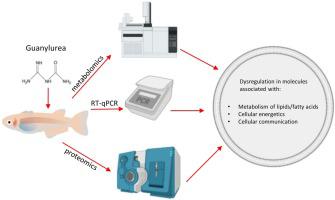Aquatic Toxicology ( IF 4.1 ) Pub Date : 2021-01-29 , DOI: 10.1016/j.aquatox.2021.105761 Erin J Ussery 1 , Kristin M Nielsen 2 , Denina Simmons 1 , Zacharias Pandelides 1 , Chad Mansfield 3 , Douglas Holdway 1

|
Metformin is a widely prescribed pharmaceutical used in the treatment of numerous human health disorders, including Type 2 Diabetes, and as a results of its widespread use, metformin is thought to be the most prevalent pharmaceutical in the aquatic environment by weight. The removal of metformin during the water treatment process is directly related to the formation of its primary degradation product, guanylurea, generally present at higher concentrations in surface waters relative to metformin. Growth effects observed in 28-day early life stage (ELS) Japanese medaka exposed to guanylurea were found to be similar to growth effects in 28-day ELS medaka exposed to metformin; however, effect concentrations were orders of magnitude below those of metformin. The present study uses a multi-omics approach to investigate potential mechanisms by which low-level, 1 ng · L−1 nominal, guanylurea exposure may lead to altered growth in 28-day post hatch medaka via shotgun metabolomics and proteomics and qPCR. Specifically, analyses show 6 altered metabolites, 66 altered proteins and 2 altered genes. Collectively, metabolomics, proteomics, and gene expression data (using qPCR) indicate that developmental exposure to guanylurea exposure alters a number of important pathways related to the overall health of ELS fish, including biomolecule metabolism, cellular energetics, nervous system function/development, cellular communication and structure, and detoxification of reactive oxygen species, among others. To our knowledge, this is the first study to both report the molecular level effects of guanylurea on non-target aquatic organisms, and to relate molecular-level changes to whole organism effects.
中文翻译:

采用组学方法研究环境相关浓度的鸟苷脲暴露对日本青鳉 (Oryzias latipes) 的生长影响
二甲双胍是一种广泛用于治疗多种人类健康疾病(包括 2 型糖尿病)的处方药物,由于其广泛使用,二甲双胍被认为是水生环境中按重量计算最普遍的药物。水处理过程中二甲双胍的去除与其主要降解产物脒基脲的形成直接相关,与二甲双胍相比,脒基脲通常在地表水中的浓度较高。研究发现,暴露于脒脲的 28 天生命早期阶段 (ELS) 日本青鳉的生长效果与暴露于二甲双胍的 28 天 ELS 青鳉的生长效果相似;然而,效果浓度比二甲双胍低几个数量级。本研究采用多组学方法,通过鸟枪法代谢组学、蛋白质组学和 qPCR,研究低水平的 1 ng·L -1标称鸟苷脲暴露可能导致孵化后 28 天青鳉生长改变的潜在机制。具体来说,分析显示 6 个改变的代谢物、66 个改变的蛋白质和 2 个改变的基因。总的来说,代谢组学、蛋白质组学和基因表达数据(使用 qPCR)表明,在发育过程中接触鸟苷脲会改变与 ELS 鱼整体健康相关的许多重要途径,包括生物分子代谢、细胞能量学、神经系统功能/发育、细胞通讯和结构,以及活性氧的解毒等。据我们所知,这是第一项报告脒基脲对非目标水生生物的分子水平影响,并将分子水平变化与整个生物体影响联系起来的研究。











































 京公网安备 11010802027423号
京公网安备 11010802027423号